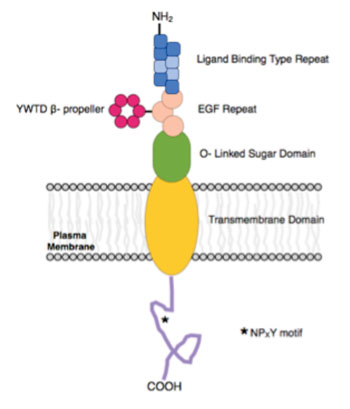Risk of Cardiovascular Disease Linked to Apolipoprotein E Variants
By LabMedica International staff writers
Posted on 30 Sep 2014
The apoE4 variant form of circulating apolipoprotein E (apoE) leads to increased risk of cardiovascular disease by blocking binding of the normal apoE3 form to the apoliprotein E receptor 2 (apoER2) in the membranes of endothelial cells lining the walls of blood vessels and by interacting with the receptor without stimulating production of anti-inflammatory nitric oxide (NO). Posted on 30 Sep 2014
Nitric oxide is a crucial physiological messenger molecule that plays a role in blood pressure regulation, control of blood clotting, immune defense, digestion, the senses of sight and smell, and possibly learning and memory. In addition to heightened susceptibility to cancer and neurodegenerative diseases, nitric oxide deficiency has been linked to diverse disease processes such as diabetes, stroke, hypertension, impotence, septic shock, and long-term depression.

Image: Illustration of the apoER2 receptor protein shows the structure of the entire protein in detail (Photo courtesy of Wikimedia Commons).
ApoER2 is a membrane protein made up of 870 amino acids. It is separated into a ligand binding domain of eight ligand binding regions, an EGF-like domain containing three cysteine-rich repeats, an O-linked glycosylation domain of 89 amino acids, a transmembrane domain of 24 amino acids, and a cytoplasmic domain of 115 amino acids, including an arginine-proline-any amino acid-tyrosine (NPXY) motif.
Investigators at the University of Texas Southwestern Medical Center (Dallas, USA) worked with cell culture and mouse models to determine how the interaction between apoE variants and the apoER2 receptor influence risk of developing cardiovascular disease.
They reported in the September 2, 2014, online edition of the journal Proceedings of the National Academy of Sciences of the United States of America (PNAS) that in endothelial cells apoE3 binding to ApoER2 stimulated endothelial NO synthase (eNOS) and endothelial cell migration, and it also attenuated monocytes-endothelial cell adhesion. However, apoE4 did not stimulate eNOS or endothelial cell migration or dampen cell adhesion, and alternatively it selectively inhibited apoE3/apoER2 actions. Approximately 15% of individuals possess the gene coding for apoE4, and these individuals are at increased risk of developing atherosclerosis and coronary heart disease.
The investigators also identified in endothelium a nonfunctional variant of apoER2, apoER2-R952Q, which failed to generate production of NO after interaction with apoE3.
"We believe that we have identified one mechanism by which apoE3 promotes a healthy cardiovascular system and why a genetic variant, apoE4, is detrimental," said senior author Dr. Philip Shaul, professor of pediatrics at the University of Texas Southwestern Medical Center. "An important mechanism that is lost when people possess apoE4 is the ability to produce NO, which leads to a loss of both the reparative and anti-inflammatory capacities of the endothelium. Now, knowing this information, we believe such individuals may benefit from treatment with an NO donor. There is a form of aspirin, for instance, that is an NO donor."
Related Links:
University of Texas Southwestern Medical Center







 assay.jpg)






